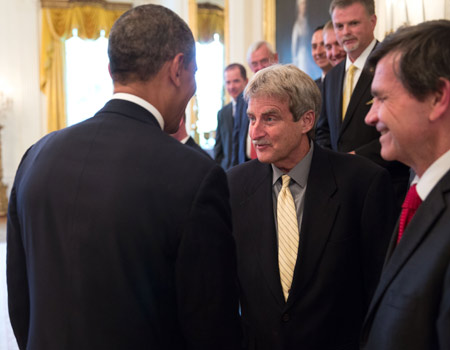
NOAA's Mark DeMaria gets White House visit with President
DeMaria was joined by 27 winners and finalists of the 2013 Samuel J. Heyman Service to America Medals, or Sammies, which honor federal employees who have made significant contributions to America. Honorees are chosen based on their commitment and innovation, as well as the impact of their work on addressing the needs of the nation. DeMaria was named a finalist for his work in developing several hurricane and wind-speed prediction models. NOAA's National Hurricane Center uses these models to track tropical cyclone activity. 
"Meeting the president was great," said DeMaria, a finalist for the award. "Although it was pretty brief, he talked with us as a group and individually and asked each of us what our award was for and shook our hands one by one." Recognized as one of the top scientists in storm prediction, DeMaria created models to better forecast the path and intensity of hurricanes during the past 30 years that have helped emergency managers make critical decisions about evacuations and first responders prepare for the severe storms, saving lives, homes and businesses.Some of DeMaria's forecast model advancements, for example, were used last year during Hurricane Sandy, providing information about the locations that would experience hurricane or gale force winds and when the hurricane would make landfall. His other models help meteorologists understand how hurricanes decay after landfall and help them forecast a storm's rapid intensification. DeMaria also has made heavy use of satellite data and analyses of lightning and oceanic heat content, to improve hurricane intensity forecasts. Right now, he is working on the next-generation GOES-R geostationary lightning mapper, which aims to quantify what lightning can tell us about storm intensification, and the Hurricane Forecast Improvement Project, which seeks to further improve hurricane forecasting. |
|
 25 October 2013 - STAR's Mark DeMaria,
a renowned expert and pioneer in hurricane research and
prediction with CoRP's Regional and Mesoscale Meteorology Branch at
25 October 2013 - STAR's Mark DeMaria,
a renowned expert and pioneer in hurricane research and
prediction with CoRP's Regional and Mesoscale Meteorology Branch at